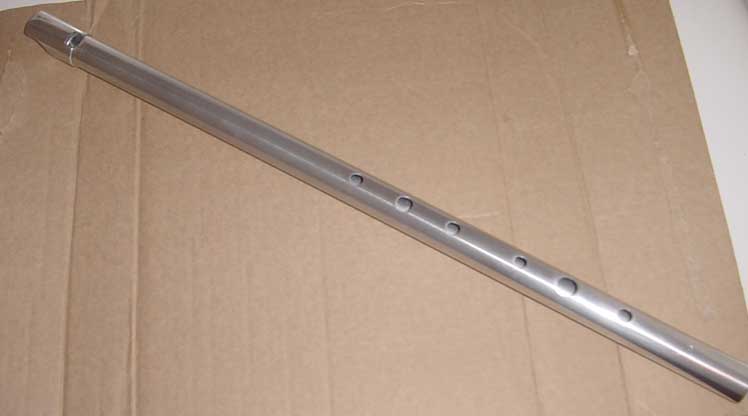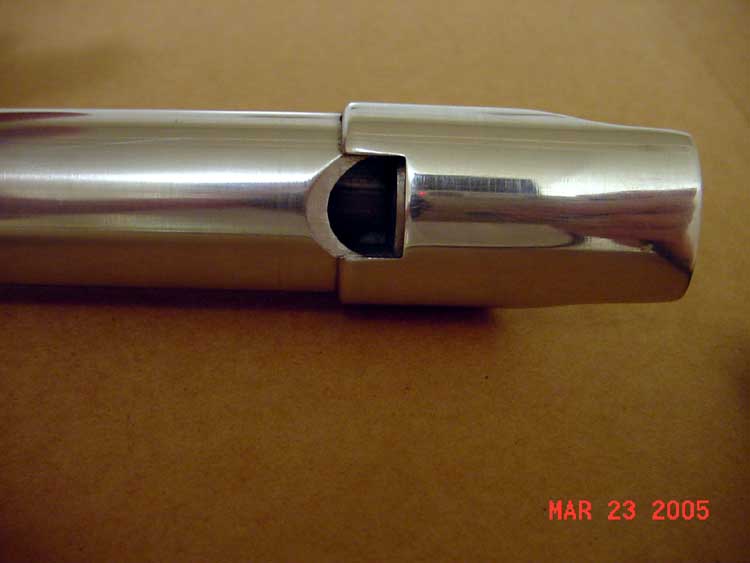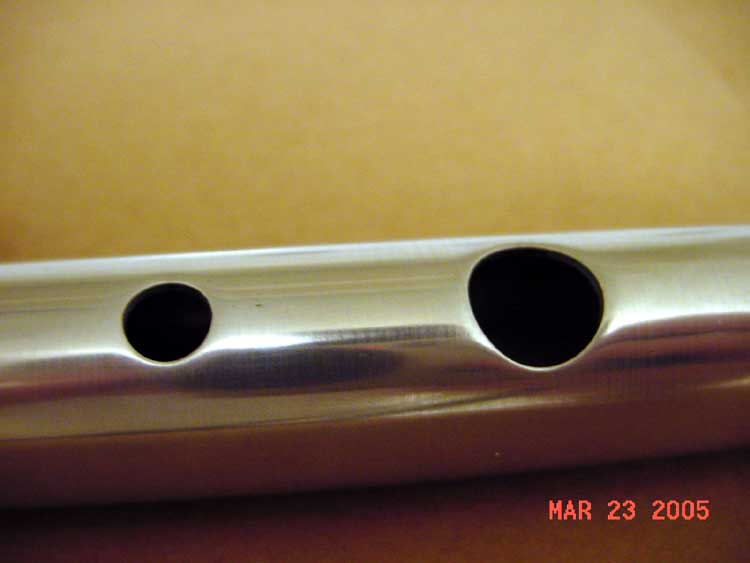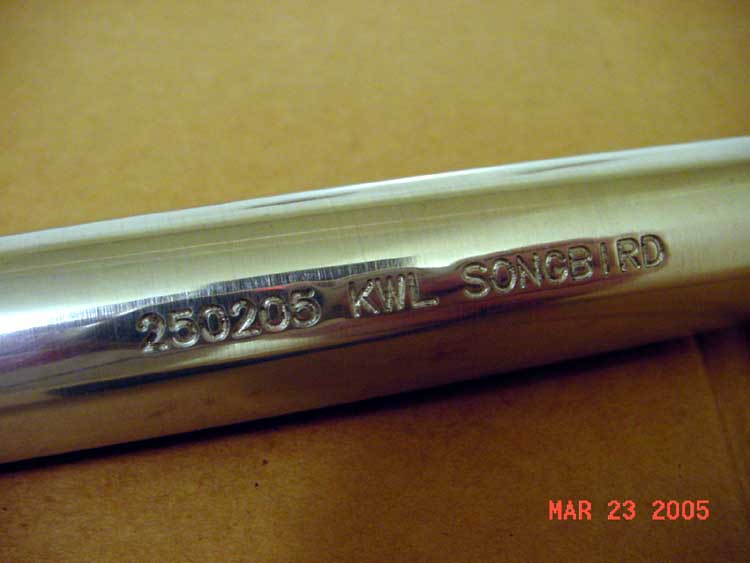review housed at http://www.tinwhistler.com/music/reviews.asp
Kerry Songbird Low D
(Review written March 2005)
Preface
Phil Hardy has started making the Kerry Songbird as a low D. It’s like a Kerry Songbird, but in the lower octave, naturally. In order to keep costs down, Phil is only offering these through his own site at kerrywhistles.com. Phil was kind enough to send me one from his first production run to test out, so you guys get to hear about it right away!
At a Glance
Whistle Reviewed: Kerry Songbird non-tunable Low D
Models Available: D and low D, tunable and non-tunable.
Construction: Aluminum with aluminum mouthpiece.
Price at time of review: £69 non-tunable, £99 tunable (convert from GBP to your currency here: xe.com)
Available From: kerrywhistles.com
How Acquired: Product sample from Phil Hardy
Bottom Line: Similar to the New Range Chieftain Low D, though more rich and mellow.
Appearance/Construction
The Songbird Low D looks quite similar to the Chieftain line of whistles that Phil produces (see my Chieftain reviews if you haven’t already). It’s got a similar-looking sleek aluminum body, but the Songbird also has an actual mouthpiece. This makes it look less like something homemade. I expect I’ll get the “Did you make that yourself?” question a lot less with this one. Not that I think I could make a Chieftain, mind you. They’re just so minimalist in design, I just seem to get that question a lot.

And here it is! I think there can be a tendency on low D’s for the mouthpiece to look freakishly huge (at least on those designs that have a seperate mouthpiece). It can look as if the maker has taken their high D design and just multiplied all of the dimensions (height, width, etc) by two to get a low D version. The Howard comes to mind. I think, in contrast, Phil’s low D mouthpiece avoids that look, and comes across as more sleek and stylish.

Speaking of the mouthpiece, here’s it is. Notice the labium ramp, which is dramatically different from the Chieftain line. Here, we have a curved half-moon of a blade. Not being a whistle-smith, I’m not sure in the advantage gained, but there are definite differences between the sound of this whistle and the Chieftain range, and I’m sure this different labium ramp plays some part in that.

I was pretty sure that the toneholes felt smoother on the Songbird. Upon putting it side-by-side with my Chieftain, it’s definite..the holes are chamfered and polished.

Like the Chieftain range, these are numbered on the back near the bell end. I’m pretty sure that this is the date of manufacture, rather than a unique serial number. Not really useful in proving an instrument is yours, but useful in a more abstract way, such as if certain batches of instruments turn out to be particularly good or bad.
Playing Characteristics
This whistle shares a lot of the playing characteristics of the Chieftain range of instruments. But the Songbird low D is mellower than the Chieftain. I’d call the Chieftain “bright” sounding in comparison. The Songbird has a richer timbre, with a bit more airiness and a bit less volume. The differences between the Kerry Songbird and the New Range Chieftain low whistles is quite subtle, however.
A sound clip of the whistle:
Stack of Rye Here’s Stack of Rye with this whistle, so you can compare it to the two Chieftain reviews I have on the site.
Volume: This whistle is on the quiet side. It’s not as loud as the New Range. I took it to Friday session–which is a large session with usally 10 or more musicians in a rowdy pub–and had a hard time being heard. Good for if you were recording, had a mic, or in a quieter session.
Responsiveness: Because of it’s mellow nature and weaker D and E notes, ornaments don’t sound as bright and crisp on those notes as higher on the whistle or on a more chipper instrument. That said, I was able to play this whistle about as quickly as my Chieftain New Range. It just wasn’t as crisp sounding in the very bottom of the scale.
C-Natural: OXXOOO produces a c-natural that’s perhaps 5 cents flat (which isn’t much) with the expected breath pressure. OXOOOO is about 5 cents sharp. Both are easily brought into line with a little breath control, so choose the method you like best.
Tuning: This whistle is in tune when warmed. That said, the lowest notes (D and E) were a little weak. They took a little less breath to be in tune than the rest of the whistle. If I played them with the breath requirements I’d expect, they run about 15 cents sharp.
Hole Size and placement: Similar hole placement to a Chieftain New Range. The E hole is slightly larger than average, and the bottom hole is closer (and thus more manageable) than some low D’s..for instance, the Copeland Low D bottom hole is quite far from the next hole up in comparison.
Air volume and pressure requirements: The whistle has a little more back pressure than the New Range Chieftains, but not as much as the Old Range Chieftains, especially in the upper octave. It also requires a little more air than the New Range Chieftains..but not much.
Clogging: This whistle, like all aluminum whistles I’ve played, gets wet pretty quick. Especially when the mouthpiece hasn’t been sufficiently warmed. Unfortunately, unlike the Chieftain line, the windway isn’t self-clearing. Eventually, you’ll need to blow it out and keep on going, which is pretty easy to do. I ended up treating the windway with Duponol and haven’t had any issues since. This is a detergent-action chemical (also sold in recorder circles under the name AntiCondens) that sells for about $3.00 a bottle, and that bottle will last you a long long time.
Misc Notes: Like the Chieftain line, this whistle is wind susceptible. I really can’t play much outside in Dallas with it, as it’s a lot more windy here than Houston.
Summary
If you liked the mellowness of Phil’s old style Chieftain’s, and perhaps find his new range a little too bright, you’ll love the tone on this one. It’s got that great “turn the lights down low” romantic sound to it, while still being much easier to play than the original Chieftains.
(edited to correct a grammatical error ![]() )
)

